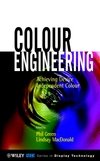
Phil Green and Lindsay MacDonald, Colour Engineering, Wiley.
Digital camera makers, printer manufacturers, image processing software authors and the whole of the printing and imaging content industry share a need for allowing color information to move seamlessly between acquisition, archiving and display. This desire for hardware-independent seamlesness is manifest in the creation of the International Color Consortium (ICC), and translates into the subtitle of the Green and Lindsay's book, " Achieving Device Independent Color".
The science of color is grounded in physics and psychology; however the practical use of color in capture, display and reproduction of imagery relies heavily on descriptive formalisms, measurement devices, computer software, and the quirks of today's capture and display hardware. This is technology, not science. And anyone wishing to write code to manipulate color information benefits from an overview of these details.
Green and MacDonald have edited a book composed of information-packed peer-reviewed survey chapters which taken together supply an overview and tutorial introduction of the implementation details of color technology, as it stood in 2002. Colour Engineering bridges the considerable gap between simplified texts such as Abhay Sharma's "Understanding Color Management" and current research.
A reader desiring to enter the field will find assembled here most of the technical background material needed in order to quickly use Matlab or another toolkit to manipulate color imagery and color transforms, and an invaluable chapter by chapter bibliography. Colour Engineering is an essential resource that should find itself on the bookshelf of every color scientist, hardware designer and color software author.
NB - this review is not yet finalized.
Digital camera makers, printer manufacturers, image processing software authors and the whole of the printing and imaging content industry share a need for allowing color information to move seamlessly between acquisition, archiving and display. This desire for hardware-independent seamlesness is manifest in the creation of the International Color Consortium (ICC), and translates into the subtitle of the Green and Lindsay's book, " Achieving Device Independent Color".
The science of color is grounded in physics and psychology; however the practical use of color in capture, display and reproduction of imagery relies heavily on descriptive formalisms, measurement devices, computer software, and the quirks of today's capture and display hardware. This is technology, not science. And anyone wishing to write code to manipulate color information benefits from an overview of these details.
Green and MacDonald have edited a book composed of information-packed peer-reviewed survey chapters which taken together supply an overview and tutorial introduction of the implementation details of color technology, as it stood in 2002. Colour Engineering bridges the considerable gap between simplified texts such as Abhay Sharma's "Understanding Color Management" and current research.
A reader desiring to enter the field will find assembled here most of the technical background material needed in order to quickly use Matlab or another toolkit to manipulate color imagery and color transforms, and an invaluable chapter by chapter bibliography. Colour Engineering is an essential resource that should find itself on the bookshelf of every color scientist, hardware designer and color software author.
NB - this review is not yet finalized.
2 comments :
Edmund, the link to the Amazon page should be fixed.
Fixed, I hope. Thank you.
Post a Comment